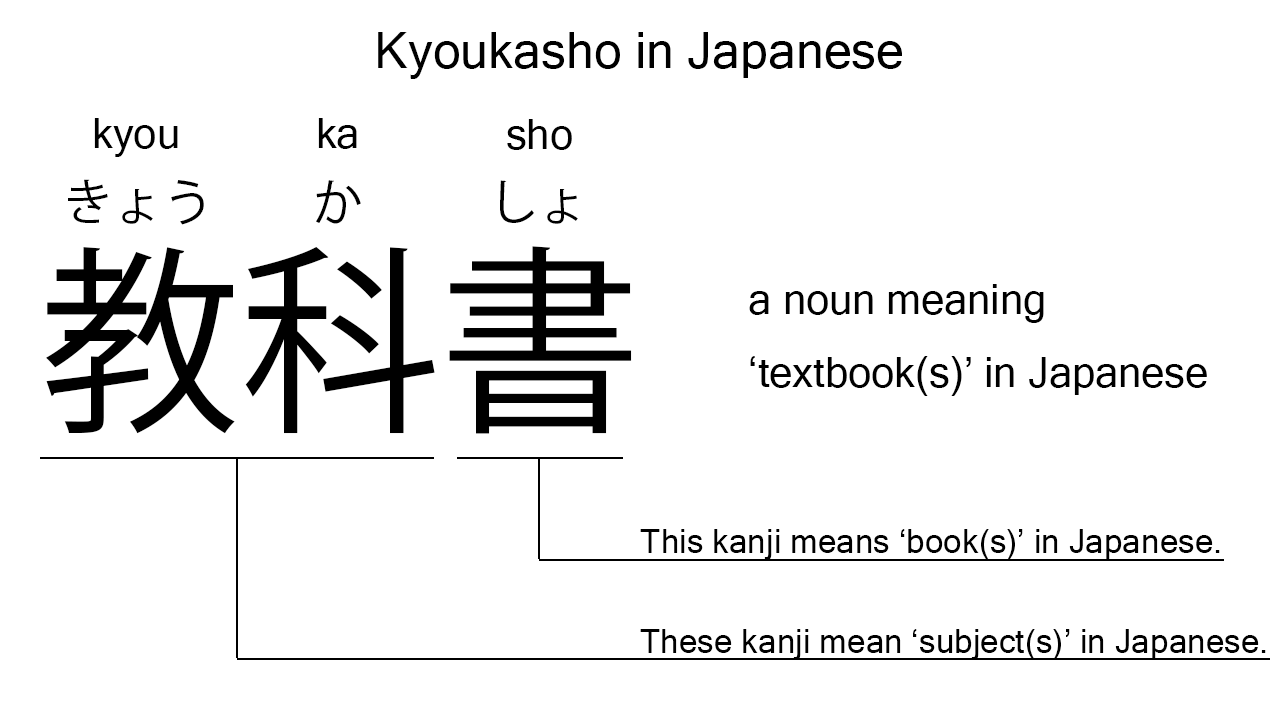What does “kyoukasho” mean in Japanese?
Native speakers say “kyoukasho” to mean ‘textbook’ in Japanese. Perhaps, some Japanese learners know this word as it is sometimes used in Japanese textbooks. In this blog post, however, I will explain this word in detail based on its kanji expression. And also, I will explain how to use it through example sentences. My explanations would help Japanese learners understand “kyoukasho” more clearly. Then, let’s get started!
Contents
Definition and meaning of “kyoukasho”
Let me start with the definition and meaning of “kyoukasho”.
- kyoukasho – 教科書 (きょうかしょ) : a noun meaning ‘textbook’ in Japanese. This can also work as plural. Learn more about Japanese plural.
The definition and meaning are simple and clear. To understand this noun more clearly, however, let me explain its kanji expression in detail.
What does “kyoukasho” literally mean in Japanese?
The kanji expression of “kyoukasho” consists of the following two parts:
- kyouka – 教科 (きょうか) : a noun meaning ‘subject’ in Japanese. This can also work as plural.
- sho – 書 (しょ) : a noun meaning ‘book’ in Japanese. This can also work as plural.
From these two parts, we can understand that “kyoukasho” literally means ‘books for subjects’ in Japanese. This literal interpretation is not completely in line with the actual meaning, but still understandable, I think. Textbooks are often books for subjects at school.

When we meet new kanji expressions, we should check their kanji characters in detail to understand their meanings clearly and deeply. In many cases, kanji characters tell us a lot about the meanings of the expressions they form. Actually, here, we could get the better understanding of “kyoukasho” through the detailed kanji check above.
So far, I’ve explained the definition and meaning of “kyoukasho” together with its kanji expression. Then, let me explain how to use it through the example sentences below.
Example #1: how to say “textbook” in Japanese
watashi wa nihongo no kyoukasho wo yon da – 私は日本語の教科書を読んだ (わたしはにほんごのきょうかしょをよんだ)
I read a Japanese textbook.
Below are the new words used in the example sentence.
- watashi – 私 (わたし) : a pronoun meaning ‘I’ in Japanese.
- wa – は : a binding particle working as a case marker or topic marker. In the example, this works after “watashi” to make the subject in the sentence.
- nihongo – 日本語 (にほんご) : a noun meaning ‘Japanese’ or ‘the Japanese language’ in Japanese.
- no – の : a case particle joining two nouns. Normally, the first one can work as a modifier to describe the second. In the example, this works to join “nihongo” and “kyoukasho”. The formed phrase literally means a ‘Japanese textbook’ in Japanese.
- wo – を : a case particle used to make the object word in a sentence. In the example, this works after “nihongo no kyoukasho” to make the object in the sentence.
- yon – 読ん (よん) : one conjugation of the verb, “yomu“, which means ‘to read’ in Japanese. In the example, it has been conjugated for the better connection with its following word.
- da – だ : an auxiliary verb used after a verb, adjective, or auxiliary verb to make its past tense form. In the example, this is used after “yon” to make its past tense form, “yon da”.
This is a typical usage of “kyoukasho”. In this example, it works together with “nihongo” and “no” to mean a ‘Japanese textbook’ in Japanese.
Example #2: another usage of “kyoukasho”
boku wa atarashii kyoukasho wo kat ta – 僕は新しい教科書を買った (ぼくはあたらしいきょうかしょをかった)
I bought new textbooks.
Below are the new words used in the example sentence.
- boku – 僕 (ぼく) : a pronoun meaning ‘I’ in Japanese. This is used mainly by boys and young males.
- atarashii – 新しい (あたらしい) : an i-adjective meaning ‘new’ in Japanese.
- kat – 買っ (かっ) : one conjugation of the verb, “kau“, which means ‘to buy’ in Japanese. In the example, it has been conjugated for the better connection with its following word.
- ta – た : an auxiliary verb used after a verb, adjective, or auxiliary verb to make its past tense form. In the example, this is used after “kat” to make its past tense form, “kat ta”.
This is another typical usage of “kyoukasho”. In this example, it works together with “atarashii” to mean ‘new textbooks’ in Japanese. When we want to mean a ‘textbook’ or ‘textbooks’ in Japanese, anyway, this noun is always a very good option.
Summary
In this blog post, I’ve explained the definition and meaning of “kyoukasho” in detail based on its kanji expression. And also, I’ve explained how to use it through the example sentences. Let me summarize them as follows.
- kyoukasho – 教科書 (きょうかしょ) : a noun meaning ‘textbook’ in Japanese. This can also work as plural. This kanji expression literally means ‘books for subjects’ in Japanese. This literal interpretation is not completely in line with the actual meaning, but still understandable, I think. Textbooks are often books for subjects at school.
Hope my explanations are understandable and helpful for Japanese learners.
Leave a Reply